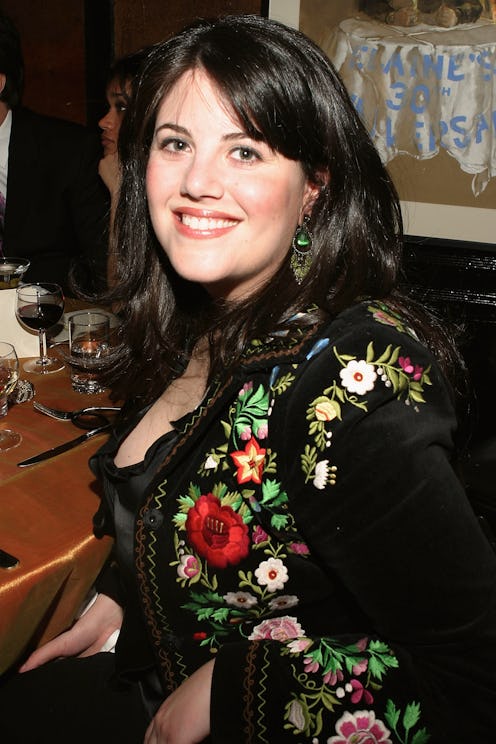You don't have to look too far to find someone with a negative opinion of Monica Lewinsky, even 18 years after news of the affair between her and then-president Bill Clinton first broke. The mediums may be different — instead of seeing degrading headlines about her plastered across newsstands, you can find tweets about how hopefully Lewinsky "doesn't blow it" with her new Twitter account, or memes calling for Monica for President, because she "got the job done when Hillary couldn't." Monica Lewinsky jokes have definitely slipped in cultural relevance, but the stigma around her — lines of thinking that paint her as the gold-digging villain, the home wrecker, the intern that seduced the president with a sexual prowess that threatened to bring down the Oval Office — has never left our collective memories. If you're looking for proof, see the 2014 New York Post cover which paired a picture of Lewinsky with the headline "My Life Sucks."
In 1998, I had just entered high school. It was a time when I first found myself understanding breaking news in the media and forming my own opinions about the subjects. It was the year that Mary Kay LaTourneau, who had been convicted of second degree rape of a child, violated parole by contacting her victim, 14-year-old Vili Fualaau (whom she would later marry). It was the same year that, as The New York Times reported, "The Roman Catholic Diocese of Dallas agreed ... to pay $23.4 million to eight former altar boys and the family of a ninth who say they were sexually victimized by a priest in the 1980's and early 1990's." Needless to say, consent was a huge part of the news that year, and those stories shattered much of my own innocence.
Yet despite the fact that so many of the era's top news items involved stories of violation and abuse, the person I recall being vilified the most by the media in this era was in a consensual sexual relationship (albeit, with a married man). I watched the media denigrate Monica Lewinsky over her affair with Bill Clinton in such a profound and shocking way, I believe that it impacted lasting opinions about the role of “the other woman.”
When the first rumblings of the Clinton Lewinsky affair began being whispered about, on a 1998 posting on the Drudge Report, Lewinsky was first portrayed by some as a liar. Initially, the White House denied any wrongdoing on the part of the president; later, as facts came to light that made it clear that an affair had taken place, many frowned on Clinton's behavior — he was impeached by the House of Representatives in December 1998 on charges of perjury and obstruction of justice, and then acquitted by the Senate in February 1999 — but Lewinsky was further demonized by many. Even though she turned out to be telling the truth about her affair with Clinton, it didn't seem to impact those who held negative opinions of her; in their eyes, she simply went from being a liar to a temptress, a woman whose sexual appetites nearly brought down the leader of the free world.
Even then, I felt that a 20-something intern couldn't possibly have that much power over the president, a powerful man with years more of life and sexual experience. (I didn't have much life experience, of course, but I did watch way too much TV.)
Based on watching some of my favorite '90s TV shows — like 90210, Silk Stalkings, and Melrose Place — you would believe that women in mainstream America were experiencing sexual freedom like never before. In fact, I thought I knew everything there was to know about cheating from watching these shows, and their depictions of infidelity. But in reality, women were not as free to do anything they pleased sexually, without being judged and shamed for it, as they were on basic cable. I knew this from watching the way so many people reacted to Monica Lewinsky.
As the facts of Lewinsky's affair with Clinton were unearthed, the media had a field day, often painting Monica as a young temptress. Perhaps they delighted in the fact that the entire story of the intern and the president felt so similar to those late night dramas that could only be shown after 10 p.m. But in reality, Monica wasn’t a racy character in a show. She was a real 22-year-old, who admitted to making a mistake by sleeping with a married man. Today, I can remember being 22 and making some incredibly stupid decisions — decisions that are arguably worse than sleeping with a married man. Fortunately for me, the media didn’t care about me. If they had, I might have been treated like I was worthless. … I might have been treated like Monica Lewinsky.
Interestingly enough, the country seemed split at the time on whether or not Bill Clinton's sex life impacted his ability to be our president. Too many times, the expression "boys will be boys" was tossed around as explanation for why his actions didn't matter to most people, while Monica's did. As the woman, she was supposed to know better. Her infamous semen-stained blue dress caused mortification for both Monica and Bill — yet Monica bore the brunt of the jokes because, well, boys will be boys.
For a girl who had just discovered feminism through punk bands like Bikini Kill at the time, Monica Lewinsky's treatment by the media felt contradictory to the world I thought I was growing up in. I remember thinking that Bill was the one who was married, Bill was the one who we voted in to be completely focused on the state of our nation’s affairs. Still, our expectations of Monica, a person we never elected and didn’t know anything about, far exceeded what we expected of our president. Eighteen years later, the implications of that fact still stick with me.
Images: Giphy
